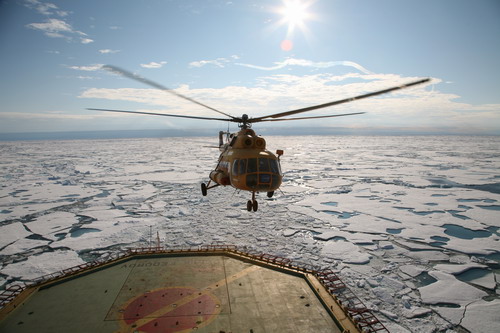Water is everywhere. Oceanographers’ research.
During the Arktika-2007 expedition in the Arctic Ocean plenty of experimentation and research is conducted. The expedition programme includes execution of deep ocean stations using the SBE 19+ and the SBE 911+ probing systems, or the Rosetta as oceanographers name it otherwise. These devices are used to measure water temperature and its salinity. Such studies provide data on the structure of sea water in the ocean depth. The scientists will be taking some measurements during the whole expedition up to the landing of the SP-35 drifting station and vice versa.

Based on the data, as well as information obtained in all such international maritime expeditions that take place during the International Polar Year (IPY), some maps of oceanographic characteristics of the Arctic Ocean will be designed. Unfortunately, as the experts note, in recent years, experiments are conducted occasionally. However, during the IPY, the number of such studies has increased dramatically. In general, the Arktika-2007 expedition and the SP-35 a large set of scientific works, including hydrological and geological ones, to be conducted. It is planned to take some samples and to obtain new data on oceanographic conditions in the high Arctic. The study of temperature, salinity and water samples allows the evaluation of the current state of the Arctic Ocean and possible climate change in the Arctic.

We recall that the International Exhibition Company, MVK is a media partner of the Arktika-2007 expedition. The purpose of the MVK expedition is to develop the exposure of the polar museum, which was first opened at the North Pole. The leader of The North Pole – new opportunities in life and business project, Alexey Shaburov said, “We clearly understand the importance of the event for the country, for the development and exploitation of the polar areas. We have established a museum dedicated to legendary Papanin and his team. Today, our task is to hold our history and the modern polar explorers’ feats through some generations”.

The exhibits of the Mobile polar museum were again in the hot seat! Together with the Mir-1 hydronauts, the Russian flag and the exhibits of the mobile historical and patriotic museum created by the company dove to the bottom of the Arctic Ocean at the North Pole at a depth of 4261. The commander of the Mir-1 crew, Anatoly Sagalevich wrote in the MVK logbook, “We installed the flag of Russia on the Arctic Ocean bed”.

Recall that the Arktika-2007 expedition has become one of the largest expeditions held by our country during the International Polar Year. During the voyage, the sea research started by the employees of the Arctic and Antarctic Research Institute (AARI) in June this year on board the nuclear icebreaker Russia is being continued. Over ten Russian research institutes and a number of foreign scientific centers are involved in the campaign.

During this expedition Russian oceanographers set a Russian flag on the bottom of the Arctic Ocean at a depth of more than 4 thousand meters. The running-off was made on two deep manned submersibles, the Mir-1 and the Mir-2. The high-latitude deep-sea expedition was headed by the Deputy Chairman of the State Duma, the Special Representative of the President of the Russian Federation on the International Polar Year and the head of the Association of Russian Polar Explorers, Artur Chilingarov.

During the second part of the trip Russia's new drifting research station, the North Pole-35 (the SP-35) will be organized. It will be open with respect to the Jubilee year for national polar explorers – 70 years ago the SP-1 drifting station started working.

During this phase of the expedition some multidisciplinary studies of the high-latitude Arctic climate system will be conducted, as well as the installation of automatic complexes and systems on a long series of observations in the central Arctic Basin will be organized.

Chief of the AARI Arctic expedition, Vladimir Sokolov, who took part in the landing of the last Russian drifting stations in the cruise of the Akademik Fedorov to the pole, was appointed the passage head.
